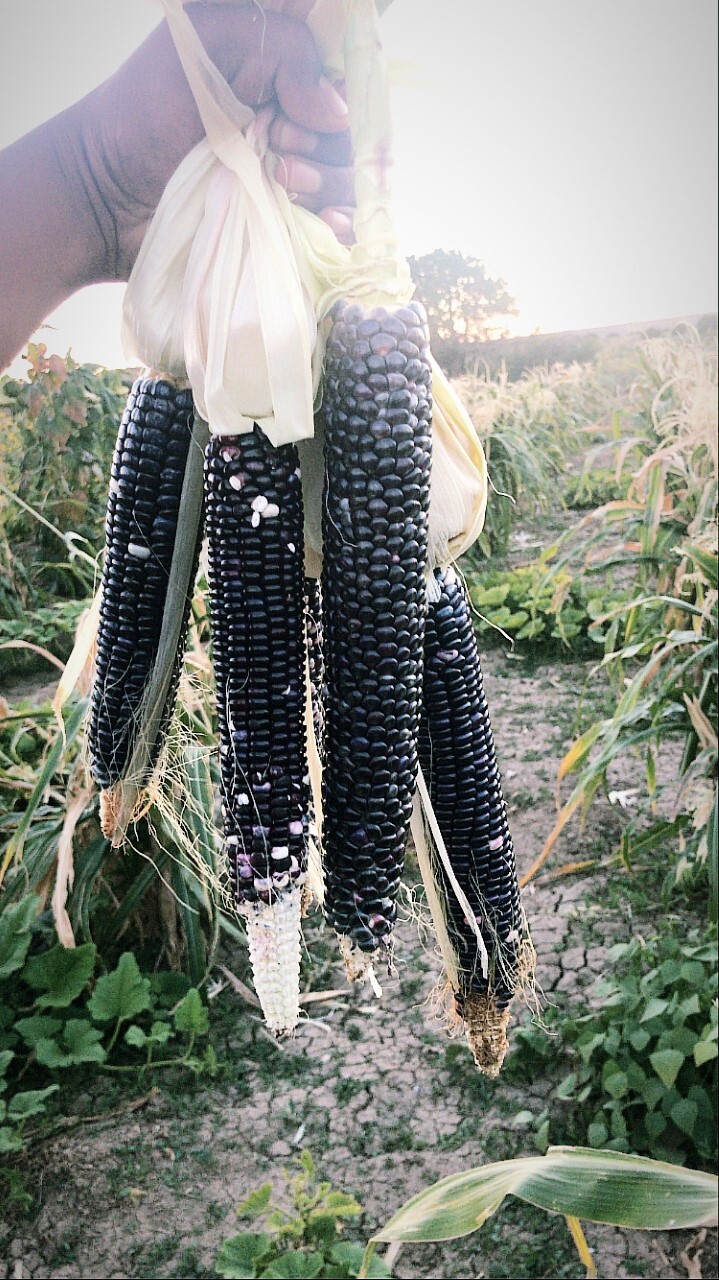This story is published in partnership with Life & Thyme.
"Each color of corn represents a cardinal direction for us: yellow to the north, blue to the west, red to the south, and white to the east. Those ears of corn literally represent our place in the world."
This is Aaron Lowden's response when I ask him how long the people of the Acoma Pueblo — one of the oldest communities in North America — have cultivated Acoma blue corn on their ancestral lands.
Lowden lives on Acoma land about an hour outside of Albuquerque, New Mexico, as his family has done for generations. He works as the Acoma program coordinator at Ancestral Lands, a nonprofit organization that supports local land stewardship in Indigenous communities.
"There are different cultivars [cultivated varieties] of blue corn in the Southwest," explains Lowden. "The blue corn that we have has defined characteristics and can range from lighter blue colors to darker blue to almost black."

Last year, Lowden was the only person in his community to grow blue corn (yaak'a goy-sh'k in the Acoma language), which symbolically represents much more than just a cardinal direction for this Southwestern population. Prior to that, no one had grown Acoma blue corn on Acoma land for years — maybe even decades.
This particular kind of corn, which is considered a "plant relative," and is therefore regarded as family to the Acoma people, went missing from the Pueblo sometime over the course of the last two generations as members of the community began working in the cash economy and ceased to rely on subsistence farming and related practices, such as seed saving, in order to feed themselves.
During this time, Acoma blue corn seeds ended up at Native Seeds/SEARCH, a nonprofit seed conservation organization based in Tucson, Arizona. Lowden describes the process of locating and then gaining access to these seeds as a "long and very difficult effort" that took place over several years. The success of this effort is due to Lowden's determination, as well as the assistance of Noah Schlager, the conservation program manager at Native Seeds/SEARCH, who Lowden claims "has been the only person to actually be a good ally to bring those seeds back."
More Stories of Restoring Foodways
Restoring a seed to its community of origin is a practice known among Indigenous people as seed rematriation and encompasses much more than the physical return of a seed to its native land. The relationship between a community and its ancestral seed must be re-established through various daily and ceremonial cultural traditions often tied to farming and cooking.
"You greet your corn when you come into the field: guwaatse hauba," says Lowden, who translates this as "hello everyone," and explains that the corn is grown along with squash and beans (together known as the Three Sisters) in the traditional Indigenous system of intercropping. He adds, "I let them know when I'm going to be back, I talk to them, I sing to them some of our traditional songs."
After the corn has been harvested and roasted, traditional songs are also sung while grinding it into a blue corn flour called kuu-maa-wits, which Lowden points out is "different than the name for white corn flour." This blue corn flour is used in numerous ways in Acoma culinary traditions for both sweet and savory dishes, and even beverages.
"Here, the locals in New Mexico call it atole, but in Acoma it's hi-yaa-nii, and that's the blue corn drink," says Lowden, explaining that blue corn flour is thinned down with water; salt and fine cedar ash are then added to prepare a nourishing beverage. "Then there's hi-yaa-shru-nee, the blue corn mush. We typically eat that salty as well, but we add in lard so it's thick, and we use that as a topping for our stews."

Preparing hi-yaa-nii, hi-yaa-shru-nee, and other Acoma dishes with Acoma blue corn represents the final step in the seed rematriation process for this particular seed and will soon be possible for the Acoma Pueblo. Lowden, the sole farmer of Acoma blue corn in 2020, will be offering seeds grown on his two-acre plot to the community later this year.
He explains the COVID-19 pandemic has had a devastating impact on food security for Acoma people, but that more food is now being grown on Acoma land as a result. The hardships of this past year have (whether willingly or out of necessity) motivated more people within the community to revive traditional Acoma farming practices, so they are now growing some of their own food and saving their own seeds.
"We went from about nine to 14 farmers per year to about 65 last year," says Lowden. This may, in turn, inspire other Acoma people to join Lowden's efforts to bring home their ancestral seeds.
More Acoma farmers and more allies outside of the Pueblo will be needed to continue the work of rematriating seeds and improving the foodways of the Acoma Pueblo, but the return of Acoma blue corn represents a hopeful step in the right direction.
The Link LonkJune 17, 2021 at 03:18AM
https://ift.tt/3q3F2SI
Acoma Blue Corn Restored to Its Community of Origin - KCET
https://ift.tt/3gguREe
Corn

No comments:
Post a Comment